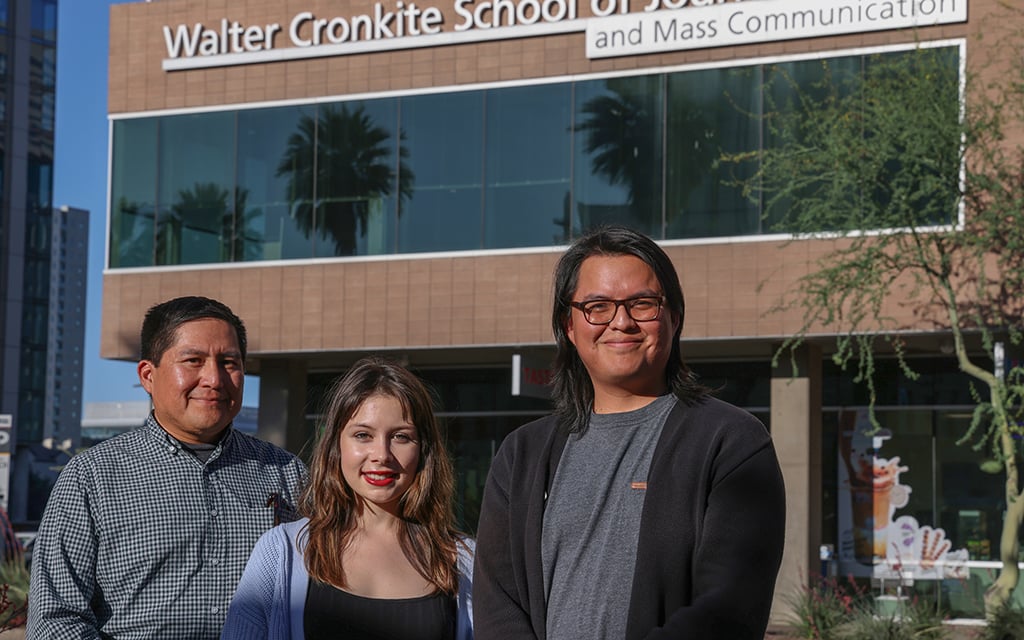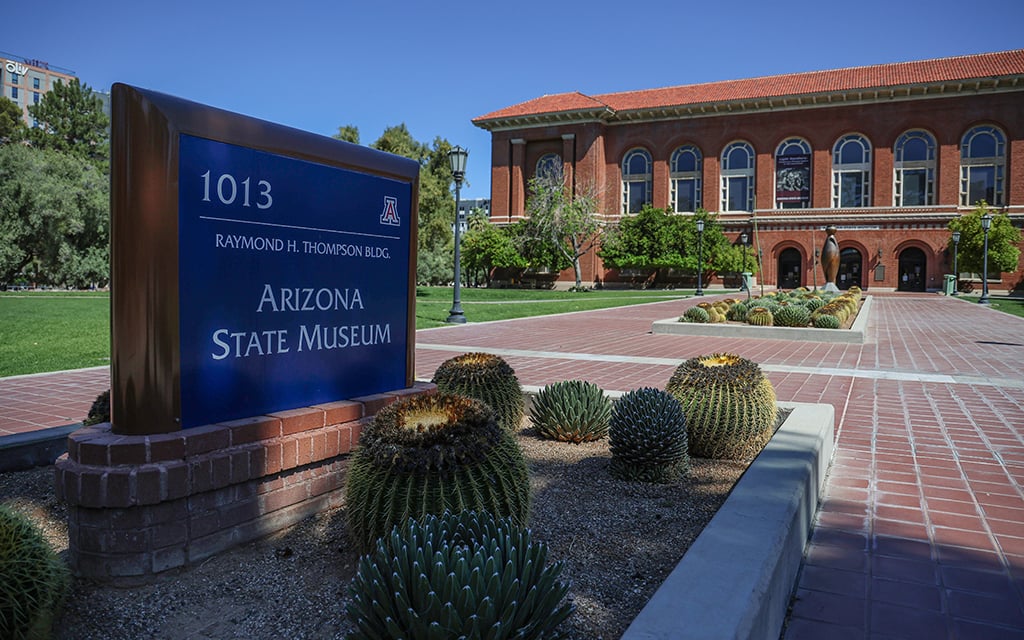
Cronkite News and Howard Center reporters, from left, Christopher Lomahquahu, Aspen Ford and Chad Bradley reported on the Native American Graves Protection and Repatriation Act and wrote about the experience as Indigenous journalists. (Photo by Aspen Ford/Cronkite News and the Howard Center for Investigative Journalism at ASU)
PHOENIX – In January, eight reporters set out to report stories about the Native American Graves Protection and Repatriation Act, or NAGPRA for short, as part of the course work for a master’s degree in investigative reporting at the Walter Cronkite School of Journalism and Mass Communication.
All early career journalists, they came from different states and different family backgrounds. Yet they all shared a keen desire to spotlight an important national issue and give readers and viewers information they didn’t have.
The reporting took them on a journey through early American history, government policy and societal attitudes toward human burial. The journey held special significance for the three Indigenous reporters who worked on the stories.
In the story below, Christopher Lomahquahu, Aspen Ford and Chad Bradley share some of what they learned from reading and analyzing original source material about NAGPRA, interviewing tribal representatives involved in repatriation and museum curators charged with returning Native American ancestors and artifacts to the tribes from which they came.
Christopher Lomahquahu, Gila River Indian Community
I have cultural ties to the Gila River Indian Community and Hopi Tribe, so reporting investigative stories about NAGPRA was an exploration of the successes, shortcomings and nuances that make this law more than a goodwill gesture to Native peoples.
Indigenous human remains were excavated throughout the country and held in the collections of universities and institutions for many years prior to NAGPRA.
Our stories are about the human remains that have yet to be returned and those that are slowly making their journey home. For me, these people are our ancestors, individuals who lived hundreds of years before our time.
Their story doesn’t end in a box on a shelf among other remains and artifacts; it’s about the legacy they have left behind, what history they can tell us about the peoples who inhabited these lands long before the urban sprawl of cities like Phoenix, Tucson and others across Arizona.
In talking with tribal historic preservation and cultural experts, I came to understand how the human remains and artifacts contain the history of the people, whether they be the Huhugam or Pueblos – pieces of our heritage not found in history books or records.
Without these pieces of history, the story of our modern-day ancestors would be incomplete. Our ancestors were skillful artisans and tradespeople who developed the ability to adapt to the desert environment.
For communities that have gone through the exhaustive process of repatriation, a sense of healing also emerges – healing for the wrongs that have been inflicted on us through practices, policies and worldviews that conflicted with Indigenous people and our culture.
As an Indigenous reporter, reporting and writing is an extension of my cultural identity, in the way others exhibit through art, music and traditional forms of expression. I hope these stories provide an opportunity for the public to learn about NAGPRA and to understand why it is important to Indigenous people today.
Aspen Ford, United Keetoowah Band of Cherokee Indians
I am extremely grateful to have reported on repatriation. I’ve interviewed Indigenous leaders, archaeologists, museum curators and students. I look back at our work over the past months and feel a deeper understanding for people on all sides of NAGPRA.
It seems that almost everyone is on the same page: return the ancestors. But the process of the law, the perceived “legal loopholes” and the lack of prioritizing NAGPRA at many institutions has made the process of repatriation long and difficult.
Native American tribes are not a monolith. There are different cultures, politics and opinions on NAGPRA. But the gesture of repatriation doesn’t tie into culture so much as it does to humanity.
The ancestors of present-day tribes were taken from their graves, stored in boxes on shelves and at least some were studied. To learn about the lack of progress in returning them by many prominent institutions around the country was disheartening for me.
Growing up in a town that’s home to two Cherokee tribes, I’d never heard of NAGPRA until a couple of years ago. It’s not acknowledged on the reservation. Many people are unaware of the act of repatriation and the history of gathering ancestors for archaeological purposes.
I hope to make more people aware of this issue and to encourage respectful conversations about the future of NAGPRA. Repatriation is a global issue and not a uniquely Indigenous one.
Now, it’s up to new generations of archaeologists and museum curators to reconcile the past.
Chad Bradley, Navajo Nation
The day we interviewed White Mountain Apache elder Ramon Riley on his tribal land, we hiked from the tribe’s museum down a short, winding trail that led to a small clearing near the White River. The spot shielded us from the day’s wind. We heard only the rushing of the water, the rustling of trees and each other, as the sun peeked through the trees.
We learned a lot about Riley and what the work to repatriate his ancestors has meant to him. He voiced the wisdom and lauded the dedication of our Native relatives who worked so hard over many decades to make repatriation a reality.
I’ve been immensely grateful to connect and learn from them, which is what I’ve always hoped for with these stories: for people to connect and to learn.
I first began reporting on repatriation in Arizona over a year ago, soon after the publication of ProPublica’s Repatriation Project, which helped reignite national interest in the issue. But for Indigenous people like me, the story wasn’t new.
The ins and outs of NAGPRA were new to me, but we are used to confronting generations of laws and policies that worked against us. Those challenges have only strengthened the resolve of Native people to confront these historical injustices.
I see such strength and resilience in each and every person who graciously shared their stories with us. I hope we can continue to tell more of them.
The Howard Center for Investigative Journalism at Arizona State University’s Walter Cronkite School of Journalism and Mass Communication is an initiative of the Scripps Howard Foundation in honor of the late news industry executive and pioneer Roy W. Howard.



